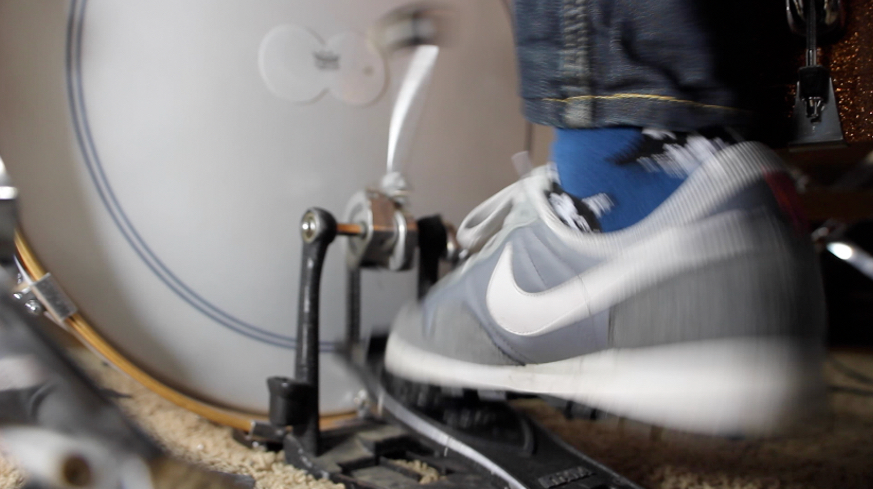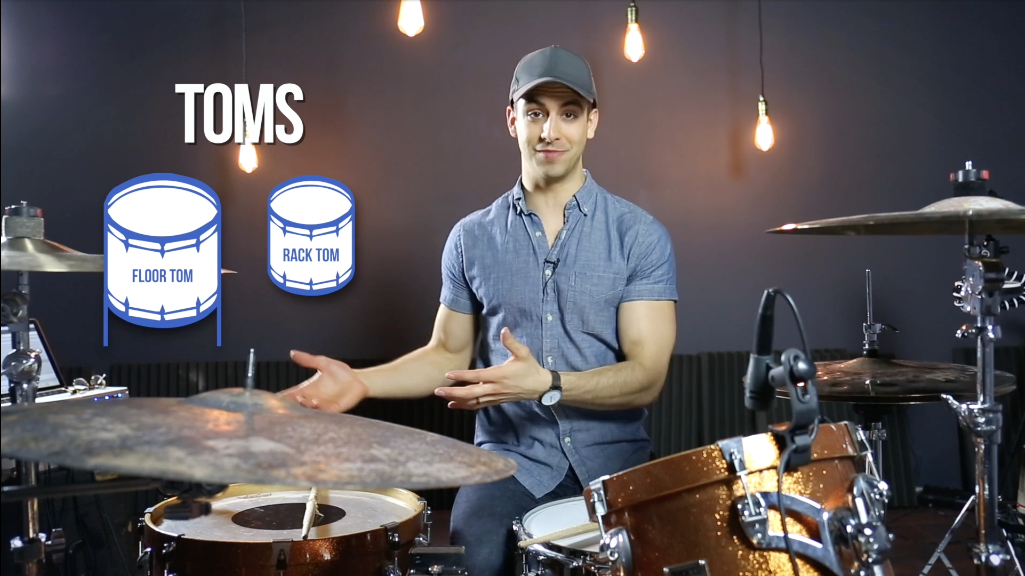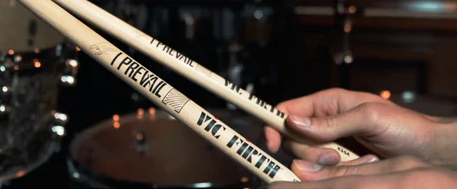Are you ready to learn how to play drums?
This guide covers the fundamentals of drumming for beginners, whether you've just purchased your first kit or are unsure how to get started. In this article, you'll find information on the following:
- Identifying drum basics
- Setting up a drum set
- Tuning a drum set
- Holding drums sticks
- Counting and reading music
- Understanding drum rudiments
- Avoiding the most common beginner mistakes
We'll go over some drum basics and short drum workouts for beginners. Even if you've never touched a pair of drum sticks before, once you finish this guide, you will feel more comfortable and familiar on your journey to becoming a drummer.

Drum Kit Basics
When you decide to learn a new skill or join a new community, you must first understand the basic terminology that will help you communicate faster and more effectively.
To learn how to play drums you will need your drum gear. A basic drum set is composed of five parts:
- The Kick Drum / Bass Drum
- The Tom Drums
- The Snare Drum
- The Hi-Hat
- The Drum Stool / Throne
Let's cover each of these briefly in the following sections
You might also be interested in: "Drum Set Parts: A Complete Overview for Beginning Drummers"The Kick or Bass Drum
The Bass Drum, also known as the 'Kick Drum' or plain 'Kick,' is the biggest of all the drums in the set. Drummers use a foot pedal to play the bass drum. To change the drum's tone, a hole can be made in the resonant head, the drum's front head.
In some cases, the resonant head is completely removed to change the drum's tone.
To control the resonance and to lessen the volume, we use a cushion or other dampening material inside a drum. The drum has feet at the front (resonant head side), known as spurs, commonly positioned so that the drum moves as little as possible while in action.
Some drummers use more than one bass drum to play faster beats with both feet. Double bass drumming is perhaps the most popular metal scene, but double pedals are used in a wide range of musical forms, from jazz fusion to pop music.

Our trusty kick drum
The Tom Drums
Tom drums are crucial for improving your drum sound. They create a lot of sounds depending on tune, depth, and size. The fundamental role of these drums is to lay down a rhythmic foundation for the other drums in the set to perform over. They are noted for their rich and deep sounds in various genres.

Gabe explains the position & purpose of the Toms in one of the first beginner lessons from DBO Academy.
The Snare Drum
The snare drum serves as the 'backbeat' of a normal straight 8's beat and is the centerpiece of the drum set. This centerpiece drum is available in several diameters, and how a drummer strikes it significantly impacts the sound generated. A snare drum can have different shells, each producing different tones. When the drum is played, the snare wires produce the distinctive "crack/snap" sound.

Photo Source: Benmclendon via Pixabay
The Hi-Hat
The hi-hat is a pair of cymbals operated by a foot pedal. The hi-hat is regarded as the most dynamic element of the drum set, as it can generate a broad range of sounds. There are various ways to play the hi-hat, including:
- Keeping the cymbals' closed.'
- Holding the cymbals' half-open.'
- Keeping the cymbals' completely open.'
- Splashing the hi-hats. This makes a sound comparable to hand-operated orchestral crash cymbals.
These playing options can be further modified by hitting different portions of the cymbal.

Photo Source: Claudia Peters via Pixabay
The Drum Stool or Throne
Every drummer needs a stool to learn to play drums. The stool is a vital part of the set and is known as the 'drum throne.' It's a round padded stool with three legs. The height of the throne is customizable to personal preference. Most drummers sit with their feet flat on the floor, and their thighs slightly slanted downwards.

The drum throne positioned next to a silver drum set. Photo Source: Jazella via Pixabay
Setting up a Drum Set
Have you recently bought your first drum set and wished you had paid someone to put it together? Once you've assembled it a few times, it'll be easy. Setting up a drum kit can vary depending on the specific kit and personal preference, but here are some general steps to follow:
- Start by placing the bass drum in the center of your drumming area, ensuring it is level and stable.
- Attach the bass drum pedal to the bass drum, making sure the beater is aligned properly with the drumhead.
- Place the hi-hat cymbals on the hi-hat stand, making sure they are tight and secure.
- Place the snare drum on the snare drum stand, making sure it is at a comfortable height for playing.
- Place the tom-tom drums on their stands, arranging them in a comfortable and ergonomic way.
- Set up the drum throne (seat) so that it is at a comfortable height and position for playing.
- Adjust the height and angle of each drum and cymbal to your preference, ensuring everything is stable and secure.
- Place the drumsticks on the drumming area within easy reach.
- Once everything is set up, take some time to sit at the kit and make further adjustments as needed to ensure that it is comfortable and conducive to good drumming.
It's also a good idea to check the tension of the drumheads and make any necessary adjustments to ensure they are at the right level of tightness. With a little patience and attention to detail, you can set up your drum kit in a comfortable way that allows you to play your best.
Watch: This ONE Hack Makes ANY Beginner Beat BETTER
Tuning a Drum Kit
Every professional has a unique method for tuning a drum kit. A classic drum kit includes a snare drum, kick drum, hi-hat, tom drums, and cymbals, which can all be tuned to multiple unfixed pitches. Regular drum tuning prevents unnecessary overtones. The following six steps are helpful for tuning:
Get a Tuner
While many experienced drummers can tune the drum kit using only their ears, it is best if you invest in a tuner as a beginner.
Detune the Drum kit
There is the top head (batter head) and the resonant (bottom head). To loosen the heads, turn the drum tension rods counterclockwise. Wipe the heads and bearing edge, replace the drum heads if needed and screw the tension rods back on.
Tighten the Head
You use a key to tighten the tension rods on a head.
You can tune the head by turning each tension rod a half-turn, full-turn, or more. To cross the lugs, start at 12 o'clock, tightening the 6 o'clock rod. Then 3, 9, and continue. .
After securing the drum heads, tighten or loosen the tension rods to change the pitch. Remember to tighten clockwise for higher pitch and loosen counter-clockwise for lowers pitch. You can use a tuner to measure the tension of each lug.
Check and Re-adjust the Pitch
Chances are you'll need to play around and fine-tune the tension rods until you reach your desired pitch. Slap the drum head after turning each tension rod and tighten or loosen the tension rods until it sounds right to the ear.
Damp the Drums
Dampening your drum sound removes undesired overtones and frequencies. Use dampening gel on your snare, floor tom, or other drums.
Repeat the process with all the other drums.
How to Hold Drum Sticks
You've set up and tuned your drum set! Let's go over how to play the drums with the correct technique. There are two ways to hold drumsticks:

- Matched grip
- Traditional grip
Matched Grip
When you hold the drum sticks in the same manner with both hands, it's called the matched grip. Your pivot point Is the pitching joint between your index finger and thumb. Your thumb should rest on the stick opposite your index finger.
There are three kinds of matched grip. The German Grip requires that you have your palms turned down while holding the drumsticks. Use your wrists to create the motion.
The American Grip requires that your hands are at a 45-degree angle. Use your finger to control the drumstick and your wrists for power.
The French Grip requires that you hold the sticks with your palms so that your thumbs are parallel to the ceiling and your palms face each other.
Traditional Grip
Jazz drummers frequently use the traditional grip. This grip requires that you "pretend" you are about to do a handshake with your left hand. The drumstick should rest in the curve between your thumb and index finger. Get comfortable by laying the drumstick on your ring finger's cuticle. Place your thumb on the knuckle of your index finger. Your middle finger needs to rest on the top of the drumstick.
You will then grip the drum stick in your right hand, similar to how you'd grip an American-matched grip, and play by rotating your forearm.
Try these different grips, see which style feels more natural, and practice your grip to develop a solid technique.
Count and Read Drum Sheet Music
Learning how to play the drums is all about keeping time.
Here we go!
A-one, a-two, a-one, two, three, four!
The drummer is the glue that holds the band together. Musicians depend on the drummer to keep the timing. To get started with your timing basics, think of timing in an organized manner. For example, a bar, or a measure, has four quarter notes. A quarter note is counted as "one, two, three, four." Learning to count quarter notes and bars will keep you on time with your beat and drum fill.
Related Reading: "Drum Notation & Sheet Music: How to Read It"
With DBO Academy, you'll learn to read sheet music. Photo Source: Pianotherapy
As a beginner, you will benefit from watching some of our drums tutorials in the Drum Beats Online Academy. Remember that to stay on time, you should count each note in the bar as one, two, three, four. If you see a plus sign, '+,' it means you need to add 'and' to help keep the timing.
When learning drums, it is best to count the notes out loud.

Photo Source: Tibor Janosi Mozes via Pixabay
Understand Drum Rudiments
Drum Rudiments are an essential part of drumming. We use rudiments as the foundation for drum beats, patterns, drum fills, and solos. It is critical to practice your fundamentals regardless of your degree of experience.
There are 40 drum rudiments, but for now, remember that five are essential for getting you started.
You might think that you have yet to learn what rudiments are. The phrase is new, but drum rudiments aren't a new notion. A rudiment is a sticking pattern, a term we use to describe which hand plays which note. You'll be able to learn how to play drums faster and have a ton of fun once you understand more about sticking and the development of control.
Drum rudiments are part of a strong foundation for drummers, so next time you play the drums, focus on which rudiments you are using. The five rudiments you should start with are the following:
- Single-stroke roll,
- Double stroke roll,
- Flam stroke,
- Paradiddle, and
- Double paradiddle

Photo Source: Simone via Pixabay
Avoid These Common Beginner Mistakes
Learning how to play drums is fun and fulfilling. It can take time to get comfortable, but it is rewarding. Making mistakes is common for beginners, but some mistakes can be avoided. Here is a list of the most common mistakes you should consider when starting:
Using the Wrong Grip
Get in the habit of paying attention to your grip every time you practice. It's a good idea to practice your grip first until you are comfortable before you jump into practicing how to play the drums. Beginner drummers tend to hold the drumsticks tight, which is one of the most common mistakes.
You should feel your drumsticks freely rebound from the drumhead while playing the drums. If your sticks don't bounce off the drums, you hold them too tightly.
Visually the drumsticks should create an arc when hitting the drumhead. Once you get comfortable, you will notice that it feels that your arms aren't even moving when beating the drums.
10 Things EVERY Beginner Drummer Does...(PLEASE STOP!)
Banging the Drum's Edge
It will take precision to play the drums. You want to avoid striking the edge of the drum and aim for the middle. Of course, depending on the type of music you are playing, it can be acceptable to aim for the edge occasionally.
You want to get into the habit of striking the middle of the drum for a more precise sound. Experiment with the position of your throne to find the best distance for your height, and avoid over-extending your arm when striking the drums.
Not Using the Metronome
When you learn to play the drums, consider practicing using a metronome. Keeping the beat is your ultimate goal. Even if you have a great sense of rhythm, using a metronome will help you improve drastically.
The aim is to get to a point where you keep the drum beat without using a metronome. Start with your metronome clicking after each beat. Once you master that, you can move on to more complex settings that will help you improve keeping the timing.
Having a Weak Bass Drum Form
A significant error beginner drummers make when playing the bass drum is bringing their foot up to press the pedal. There are two primary methods for playing the bass.
The heel-down technique implies that for the whole time you play, your foot—from toe to heel—remains on the pedal. The second option is the heel-up technique, where you press the pedal with your toes rather than your heel.

Photo Source: Artisticoperations via Pixabay
Sitting Incorrectly
Bad posture, slouching, and not engaging the right muscle groups will eventually take a toll on your body. Besides, you want to look cool while playing, right?
Playing Fast all the Time
It is best if you start playing drums by practicing a slow and steady rhythm. This will ensure you learn how to hit the drum on each count.
Final Thoughts
Drumming is a challenging skill to master, so do not be too hard on yourself. It's natural for beginners to make mistakes. You can become an excellent drummer if you are patient, break bad habits, and learn from your errors. Remember to bring a pair of sticks with you wherever you go. You'll be able to work on beats all day!
Drum Beats Online Academy is the ideal starting point for drumming for beginners. We help learners globally go from beginner to master drummers with a solid practice routine.
Who is behind DBO Academy?
Drum Beats Online Academy (DBO for short!) is led by the one and only Gabe Helguera, a professional drummer. Our academy is jam-packed with all the tips, tricks, and techniques you need to become a drumming sensation. From our DBO Academy course offerings to our highly-rated YouTube videos and blog posts, we've got you covered on your journey to drumming success.


